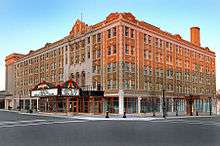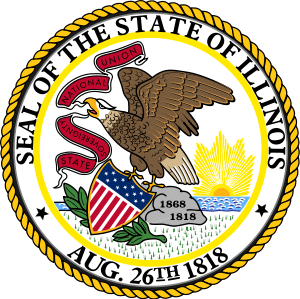Lake County, Illinois
| Lake County, Illinois | |||
|---|---|---|---|
|
| |||
| |||
 Location in the U.S. state of Illinois | |||
 Illinois's location in the U.S. | |||
| Founded | March 1, 1839 | ||
| Named for | Lake Michigan | ||
| Seat | Waukegan | ||
| Largest city | Waukegan | ||
| Area | |||
| • Total | 1,368 sq mi (3,543 km2) | ||
| • Land | 444 sq mi (1,150 km2) | ||
| • Water | 925 sq mi (2,396 km2), 67.6% | ||
| Population | |||
| • (2010) | 703,462 | ||
| • Density | 1,586/sq mi (612/km²) | ||
| Congressional districts | 6th, 10th, 14th | ||
| Time zone | Central: UTC-6/-5 | ||
| Website |
www | ||
Lake County is a county in the northeastern corner of the U.S. state of Illinois. According to the 2010 census, it has a population of 703,462,[1] making it the third-most populous county in Illinois. Its county seat is Waukegan.[2] Originally part of McHenry County, the townships composing Lake County were carved out into a separate county in 1839.
Lake County is one of the collar counties of the Chicago-Naperville-Elgin, IL-IN-WI Metropolitan Statistical Area. It is located along the shore of Lake Michigan.
According to the 2000 census, Lake County is the 31st richest county by per capita income. The lakefront communities of Lake Forest, Lake Bluff, and Highland Park are part of the affluent North Shore area.
Naval Station Great Lakes is located in the city of North Chicago in Lake County. It is the United States Navy's Headquarters Command for training, and the Navy's only recruit training center.
History

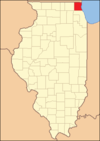
The county, which was primarily unsettled prairie and was still home to its native Potawatomi Indians, was created by the Illinois State Legislature in 1839. At that time, Libertyville, then known as Independence Grove, was the first county seat. In 1841, however, the county's residents voted to move the county government to Little Fort, now Waukegan, where the commissioners had purchased a section of land from the state. Lake County's first courthouse was built on part of that land in 1844 and the remainder was sold to pay for the $4,000 construction cost.
The county's first courthouse was used solely for court sessions and the jail, but in 1853, commissioners constructed a building to accommodate county administration offices and house records. When fire damaged the courthouse on October 19, 1875, the county records were saved because they were in the adjacent building.
After the fire, proposals were made to move the county seat to Highland Park, Libertyville or another site in central Lake County. The county commissioners, however, decided to rebuild in Waukegan. The east half of the building was reconstructed at a cost of $45,000. In 1895, the first jail building was added to the government complex and a west addition was added to the courthouse in 1922. By 1938, county commissioners saw a need for additional space and approved the addition of a 5th Floor. This courthouse, however, was demolished in 1967 to make room for a new high-rise administration building, which was completed with the addition of the jail in 1969 and courts in 1970.
Shortly thereafter, the Lake County Board commissioned the construction of a multi-faceted justice facility and ground was broken in 1986 for the Robert H. Babcox Justice Center, named in memory of Sheriff Babcox, who served as Lake County Sheriff from 1982-1988. The justice center, which houses the county jail, work release program, sheriff's administration offices and three courtrooms, was finished in 1989 at a cost of $29.6 million.
Additional county government facilities have been built or expanded throughout Lake County, including the Coroner's Office, Health Department/Community Health Center facilities, Division of Transportation, Public Works and Winchester House. Lake County government services extend throughout the county's 470 square miles (1,200 km2).
The historic Half Day Inn, a tavern/restaurant, was constructed in 1843. This structure, once located at the corner of Milwaukee Avenue and Rte. 45/Old Half Day Road, was one of the oldest structures in Lake County until it was demolished in 2007 to make way for retail space, condominiums, and a retention pond.
Geography
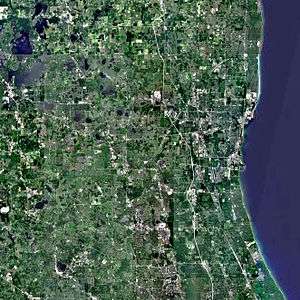
According to the U.S. Census Bureau, the county has a total area of 1,368 square miles (3,540 km2), of which 444 square miles (1,150 km2) is land and 935 square miles (2,420 km2) (67.6%) is water.[3] It is the second-largest county in Illinois by total area. Most of the water is in Lake Michigan.
State parks
Lakes
Besides Lake Michigan, lakes in the county include:
- Lake Amy
- Antioch Lake
- Ashley Lake
- Bangs Lake
- Lake Barrington
- Benet Lake
- Big Bear Lake
- Bluff Lake
- Brandenburg Lake
- Bresen Lake
- Butler Lake
- Lake Catherine
- Cedar Lake
- Channel Lake
- Lake Charles
- Countryside Lake
- Crooked Lake
- Davlins Pond
- Dead Lake
- Deep Lake
- Deer Lake
- Diamond Lake
- Druce Lake
- Duck Lake
- Dunns Lake
- East Loon Lake
- Echo Lake
- Lake Eleanor
- Elmwood Farms Lake
- Lake Fairfield
- Fish Lake
- Forest Lake
- Fourth Lake
- Fox Lake
- Gages Lake
- Lake Germaine
- Grandwood Lake
- Grass Lake
- Grassy Lake
- Grays Lake
- Harvey Lake
- Hastings Lake
- Hendrick Lake
- Highland Lake
- Honey Lake
- Homer White Lake
- Huntley Lake
- Island Lake
- Independence Grove
- Lambs Lake
- Leo Lake
- Liberty Lake
- Lake Linden
- Little Bear Lake
- Loch Lomond
- Long Lake
- Loon Lake
- Lake Louise
- Lucky Lake
- Manor Lake
- Miltmore Lake
- Minear Lake
- Mud Lake
- Lake Naomi
- Nippersink Lake
- North Tower Lake
- Petite Lake
- Pistakee Lake
- Lake Potomac
- Redhead Lake
- Redwing Slough Lake
- Round Lake
- Saint Marys Lake
- Sand Lake
- Sand Pond
- Schreiber Lake
- Shady Lane Resort Lake
- Lake Sheree
- Silver Lake
- Slocum Lake
- Slough Lake
- Spring Lake
- Sterling Lake
- Sullivan Lake
- Sun Lake
- Sylvan Lake
- Third Lake
- Timber Lake
- Turner Lake
- Twin Lakes
- Valley Lake
- Waterford Lake
- White Lake
- Wooster Lake
- Lake Zurich
Natural areas
Lake County's forest preserves and natural areas are administered by the Lake County Forest Preserves district. These facilities include traditional nature preserves, such as the Ryerson Conservation Area, as well as golf courses and historic homes, such as the Adlai Stevenson historic home.[4] A long north-south string of the preserves in Lake County, including Half Day Woods, Old School Forest Preserve, Independence Grove, and Van Patten Woods, form the Des Plaines River Greenway, which contains the Des Plaines River Trail, a popular place for walking, running, and biking. Several local environmental groups operate in Lake County, such as Conserve Lake County and Citizens for Conservation, working to improve habitat. Volunteer opportunities also exist with the Lake County Forest Preserve District.[5]
Adjacent counties
- Kenosha County, Wisconsin - north
- Allegan County, Michigan - northeast (EST Border)
- Van Buren County, Michigan - east (EST Border)
- Berrien County, Michigan - southeast (EST Border)
- Cook County - south
- McHenry County - west
Major highways
 Interstate 41
Interstate 41 Interstate 94
Interstate 94 U.S. Route 12
U.S. Route 12 U.S. Route 14
U.S. Route 14 U.S. Route 41
U.S. Route 41 U.S. Route 45
U.S. Route 45 Illinois Route 21
Illinois Route 21 Illinois Route 22
Illinois Route 22 Illinois Route 43
Illinois Route 43 Illinois Route 53
Illinois Route 53 Illinois Route 59
Illinois Route 59 Illinois Route 60
Illinois Route 60 Illinois Route 83
Illinois Route 83 Illinois Route 120
Illinois Route 120 Illinois Route 131
Illinois Route 131 Illinois Route 132
Illinois Route 132 Illinois Route 134
Illinois Route 134 Illinois Route 137
Illinois Route 137 Illinois Route 173
Illinois Route 173 Illinois Route 176
Illinois Route 176
Demographics
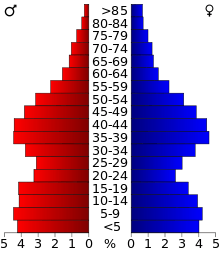
| Historical population | |||
|---|---|---|---|
| Census | Pop. | %± | |
| 1840 | 2,634 | — | |
| 1850 | 14,226 | 440.1% | |
| 1860 | 18,257 | 28.3% | |
| 1870 | 21,014 | 15.1% | |
| 1880 | 21,296 | 1.3% | |
| 1890 | 24,235 | 13.8% | |
| 1900 | 34,504 | 42.4% | |
| 1910 | 55,058 | 59.6% | |
| 1920 | 74,285 | 34.9% | |
| 1930 | 104,387 | 40.5% | |
| 1940 | 121,094 | 16.0% | |
| 1950 | 179,097 | 47.9% | |
| 1960 | 293,656 | 64.0% | |
| 1970 | 382,638 | 30.3% | |
| 1980 | 440,372 | 15.1% | |
| 1990 | 516,418 | 17.3% | |
| 2000 | 644,356 | 24.8% | |
| 2010 | 703,462 | 9.2% | |
| Est. 2016 | 703,047 | [6] | −0.1% |
| U.S. Decennial Census[7] 1790-1960[8] 1900-1990[9] 1990-2000[10] 2010-2013[1] | |||
As of the 2010 United States Census, there were 703,462 people, 241,712 households, and 179,428 families residing in the county.[11] The population density was 1,585.6 inhabitants per square mile (612.2/km2). There were 260,310 housing units at an average density of 586.7 per square mile (226.5/km2).[3] The racial makeup of the county was 75.1% white, 7.0% black or African American, 6.3% Asian, 0.5% American Indian, 8.5% from other races, and 2.6% from two or more races. Those of Hispanic or Latino origin made up 19.9% of the population.[11] In terms of ancestry, 20.5% were German, 12.9% were Irish, 9.4% were Polish, 6.9% were Italian, 6.5% were English, and 4.0% were American.[12]
Of the 241,712 households, 40.8% had children under the age of 18 living with them, 59.6% were married couples living together, 10.4% had a female householder with no husband present, 25.8% were non-families, and 21.5% of all households were made up of individuals. The average household size was 2.82 and the average family size was 3.31. The median age was 36.7 years.[11]
The median income for a household in the county was $78,948 and the median income for a family was $91,693. Males had a median income of $62,042 versus $44,200 for females. The per capita income for the county was $38,120. About 4.8% of families and 7.0% of the population were below the poverty line, including 9.6% of those under age 18 and 5.6% of those age 65 or over.[13]
Sports
The following sports teams play in Lake County:
- Lake County Fielders baseball (defunct)
- Lake County Coyotes baseball
Sites of interest
Amusement parks
Museums
- Volo Auto Museum in Volo, Illinois
- Lake County Discovery Museum in Wauconda, Illinois
- Warbird Heritage Foundation in Waukegan, Illinois
- Waukegan History Museum in Waukegan, Illinois
- Shiloh House in Zion, IL
Performing arts
- ArtWauk in Waukegan, Illinois
- Clockwise Theatre in Waukegan, Illinois
- Genesee Theatre in Waukegan, Illinois
- Ravinia Festival in Highland Park, Illinois
Other
- Downtown Waukegan
- Naval Station Great Lakes
Communities
Cities
Villages
- Antioch
- Bannockburn
- Barrington
- Barrington Hills (part)
- Beach Park
- Buffalo Grove (part)
- Deerfield
- Deer Park
- Fox Lake
- Fox River Grove
- Grayslake
- Green Oaks
- Gurnee
- Hainesville
- Hawthorn Woods
- Indian Creek
- Island Lake
- Kildeer
- Lake Barrington
- Lake Bluff
- Lake Villa
- Lake Zurich
- Lakemoor (mostly)
- Libertyville
- Lincolnshire
- Lindenhurst
- Long Grove
- Mettawa
- Mundelein
- North Barrington
- Old Mill Creek
- Port Barrington
- Riverwoods
- Round Lake
- Round Lake Beach
- Round Lake Heights
- Round Lake Park
- Third Lake
- Tower Lakes
- Vernon Hills
- Volo
- Wadsworth
- Wauconda
- Wheeling
- Winthrop Harbor
Census-designated places
Unincorporated communities
Townships
The county is divided into eighteen townships.
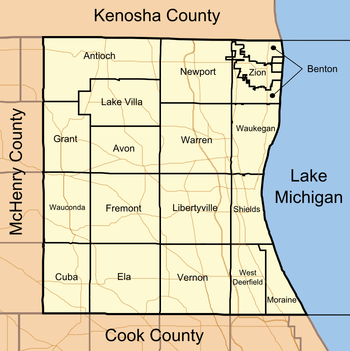
Politics
As a historic Yankee settlement, Lake County was initially a stronghold of the Free Soil Party. In the 1848 presidential election, it was Free Soil nominee and former President Martin van Buren’s strongest county, giving him over 58 percent of the vote.
Consequently, Lake County – although it did give a plurality to Franklin Pierce in 1852 – would turn rock-solid Republican for the next century. The only time between 1856 and 1960 it did not vote for the Republican Presidential nominee was in 1912 when the GOP was mortally divided and Lake County voted for Progressive Party nominee and former President Theodore Roosevelt over conservative incumbent William Howard Taft. In 1964 the Republican Party nominated Southern-leaning conservative Barry Goldwater, whose hostility to the Yankee establishment and strongly conservative policies were sufficient to drive many traditional Republicans to vote for Lyndon Johnson, who narrowly became the first Democrat to win an absolute majority in the county since James K. Polk in 1844. Between 1968 and 1988, however, Lake County became powerfully Republican once more, with no Democrat cracking forty percent of the vote.
However, the Republican edge narrowed considerably in the 1990s, and in 2008 it swung over dramatically to support Democrat and then-Illinois Senator Barack Obama, who carried it by almost 20 points. Obama won it but by a slimmer margin in 2012, and Hillary Clinton won it handily in 2016.
| Year | Republican | Democratic | Third Parties |
|---|---|---|---|
| 2016 | 36.2% 109,767 | 56.4% 171,095 | 7.5% 22,658 |
| 2012 | 45.1% 129,764 | 53.5% 153,757 | 1.4% 3,972 |
| 2008 | 39.5% 118,545 | 59.1% 177,242 | 1.4% 4,113 |
| 2004 | 50.5% 139,081 | 48.8% 134,352 | 0.7% 1,862 |
| 2000 | 50.0% 120,988 | 47.5% 115,058 | 2.5% 6,118 |
| 1996 | 45.5% 93,149 | 45.6% 93,315 | 8.9% 18,300 |
| 1992 | 44.2% 99,000 | 36.5% 81,693 | 19.3% 43,294 |
| 1988 | 63.5% 114,115 | 35.8% 64,327 | 0.7% 1,191 |
| 1984 | 68.4% 118,401 | 31.1% 53,947 | 0.5% 876 |
| 1980 | 58.5% 96,350 | 29.3% 48,287 | 12.3% 20,216 |
| 1976 | 60.3% 92,231 | 37.8% 57,741 | 1.9% 2,922 |
| 1972 | 65.8% 92,052 | 33.9% 47,416 | 0.3% 344 |
| 1968 | 56.6% 68,999 | 35.6% 43,409 | 7.8% 9,495 |
| 1964 | 48.4% 58,840 | 51.6% 62,785 | 0.0% 42 |
| 1960 | 59.0% 67,809 | 40.9% 46,941 | 0.1% 149 |
| 1956 | 67.3% 66,781 | 32.5% 32,279 | 0.1% 129 |
| 1952 | 62.8% 54,929 | 37.0% 32,353 | 0.2% 145 |
| 1948 | 63.3% 39,456 | 35.6% 22,192 | 1.2% 720 |
| 1944 | 58.2% 35,674 | 41.5% 25,453 | 0.3% 183 |
| 1940 | 60.3% 38,242 | 39.3% 24,965 | 0.4% 254 |
| 1936 | 51.3% 27,548 | 45.7% 24,524 | 3.0% 1,603 |
| 1932 | 50.9% 23,994 | 44.9% 21,139 | 4.2% 1,989 |
| 1928 | 67.7% 26,814 | 31.0% 12,252 | 1.3% 521 |
| 1924 | 75.5% 18,229 | 8.3% 2,008 | 16.2% 3,913 |
| 1920 | 82.3% 15,712 | 12.2% 2,321 | 5.6% 1,063 |
| 1916 | 67.0% 12,905 | 28.3% 5,447 | 4.8% 924 |
| 1912 | 21.6% 2,183 | 24.1% 2,436 | 54.3% 5,494 |
| 1908 | 68.2% 6,392 | 24.1% 2,264 | 7.7% 723 |
| 1904 | 77.1% 6,635 | 18.5% 1,592 | 4.4% 378 |
| 1900 | 67.7% 5,136 | 29.5% 2,235 | 2.9% 217 |
| 1896 | 72.5% 5,027 | 25.6% 1,777 | 1.9% 133 |
| 1892 | 57.2% 2,932 | 38.3% 1,964 | 4.5% 233 |
Notable people
- Jack Benny (February 14, 1894 – December 26, 1974) – entertainer, comedian, actor and musician, Benny was one of America's greatest stars of radio and television, and also appeared in many films; he was raised in Waukegan, Illinois.
- Charles Boyce (September 21, 1949) – cartoonist, creator of syndicated comic panel Compu-toon and the telecommunication public affairs image The KeyPad Kid.
- Ray Bradbury (August 22, 1920 – June 5, 2012) – fantasy, horror, science fiction, and mystery writer. Best known for his dystopian novel Fahrenheit 451 and The Martian Chronicles, Bradbury is widely considered one of the greatest and most popular American writers of speculative fiction of the twentieth century. Bradbury was born in Waukegan.
- Gary Coleman (February 8, 1968 – May 28, 2010) – actor, known for his role as Arnold Jackson in the American sitcom Diff'rent Strokes (1978–1986). Coleman was born in Zion, Illinois.
- Marlon Brando (April 3, 1924 – July 1, 2004) actor; as a young sex symbol, he is best known for his roles in A Streetcar Named Desire, On the Waterfront and Guys and Dolls. Brando and his family moved to Libertyville, Illinois where he lived from 1937 until 1942.
- Michael Jordan (born February 17, 1963) – retired professional basketball player and active businessman, widely considered one of the greatest players of all time; as of 2015, Jordan had a residence in Highland Park, Illinois.
- Vince Vaughn (born March 28, 1970) – actor, known for his roles in Swingers and Wedding Crashers; grew up in Buffalo Grove, Illinois, then moved to Lake Forest, Illinois, where he graduated from Lake Forest High School in 1988.
- Juan Rivera (October 31, 1972) - Waukegan man who was wrongfully convicted of the 1992 murder of 11-year-old Holly Skater. After his exoneration, he was awarded $20 million USD—the largest settlement for a wrongful conviction in US history.
- Ron Goldman (July 2, 1968 – June 12, 1994), who was killed along with Nicole Brown Simpson grew up in Buffalo Grove.
- Pete Wilson (born August 23, 1933), Mayor of San Diego (1971-1983); United States Senator from California (1983-1991); and Governor of California (1991-1999), born in Lake Forest.[15]
See also
- IL-53 extension issue
- List of school districts in Lake County, Illinois
- National Register of Historic Places listings in Lake County, Illinois
References
- Specific
- 1 2 "State & County QuickFacts". United States Census Bureau. Retrieved July 6, 2014.
- ↑ "Find a County". National Association of Counties. Retrieved June 7, 2011.
- 1 2 "Population, Housing Units, Area, and Density: 2010 - County". United States Census Bureau. Retrieved July 12, 2015.
- ↑ "Lake County Forest Preserves".
- ↑ "Restoration workdays". Lake County. Retrieved January 5, 2014.
- ↑ "Population and Housing Unit Estimates". Retrieved June 9, 2017.
- ↑ "U.S. Decennial Census". United States Census Bureau. Retrieved July 6, 2014.
- ↑ "Historical Census Browser". University of Virginia Library. Retrieved July 6, 2014.
- ↑ "Population of Counties by Decennial Census: 1900 to 1990". United States Census Bureau. Retrieved July 6, 2014.
- ↑ "Census 2000 PHC-T-4. Ranking Tables for Counties: 1990 and 2000" (PDF). United States Census Bureau. Retrieved July 6, 2014.
- 1 2 3 "DP-1 Profile of General Population and Housing Characteristics: 2010 Demographic Profile Data". United States Census Bureau. Retrieved July 12, 2015.
- ↑ "DP02 SELECTED SOCIAL CHARACTERISTICS IN THE UNITED STATES – 2006-2010 American Community Survey 5-Year Estimates". United States Census Bureau. Retrieved July 12, 2015.
- ↑ "DP03 SELECTED ECONOMIC CHARACTERISTICS – 2006-2010 American Community Survey 5-Year Estimates". United States Census Bureau. Retrieved July 12, 2015.
- ↑ http://uselectionatlas.org/RESULTS
- ↑
- General
- { Forstall, Richard L. (editor) (1996). Population of states and counties of the United States: 1790 to 1990 : from the twenty-one decennial censuses. United States Department of Commerce, Bureau of the Census, Population Division. ISBN 0-934213-48-8.
External links
| Wikimedia Commons has media related to Lake County, Illinois. |
- Lake County official government website
- Lake County Convention & Visitors Bureau
- Lake County Forest Preserve District
Coordinates: 42°26′N 87°47′W / 42.43°N 87.78°W


.jpg)
